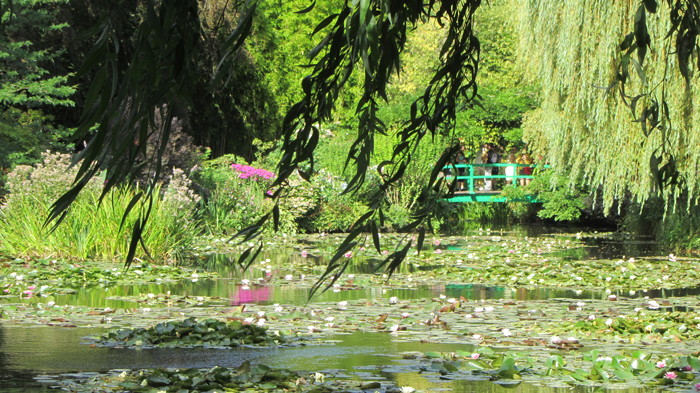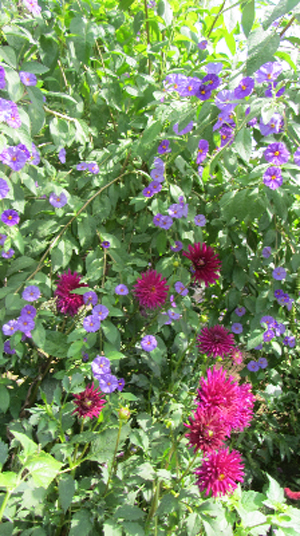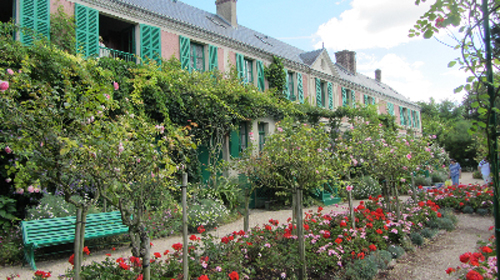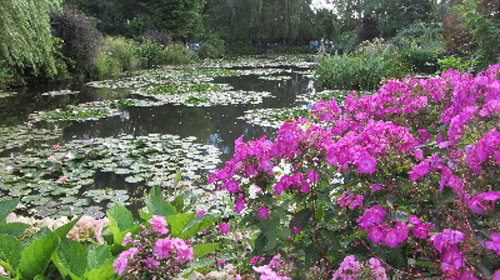Giverny – a personal reflection
 Angela Birchall invites us into Monet’s garden at Giverny for this personal reflection on her visit.
Angela Birchall invites us into Monet’s garden at Giverny for this personal reflection on her visit.
Sitting in Monet’s garden, fascinated by the ever-changing light dancing on the water surrounding his famous water lilies, suddenly brings the man and his art vividly to life.
Just 30 minutes sat by the lake close to the immortalised Japanese bridge gives you more of an insight into the life and work of the father of French Impressionism than 30 years of studying them in books can ever do.
Claude Monet is one of the few people known by both art lovers and gardeners for the same subject because the garden he created was the inspiration for so many paintings. Thus, a visit to his incredible home and gardens in Giverny in Normandy, France, is an absolute must!
Monet was one of the first artists to break out of the studio to actually paint in the open air and use nature as the main subject rather than the background. His work became a crusade to capture the changing effects of the Normandy light on objects, hence his habit of painting the same scene again and again but in different weather and lighting conditions. For Monet, there was no better way to get the perfect subject to paint than to create it in the shape of his garden. He lived in the house in Giverny for more than 40 years and in shaping the huge gardens and even bigger lily ponds (more like lakes than ponds!) he created a series of living canvases.
 The house and gardens are now kept by the Foundation Claude Monet, and are open to the public every day from late March to the end of October. Monet loved the garden’s long walkways over which he constructed archways leaving you cocooned by colour along with the dappled, dancing light coming through the overhanging foliage. Where the paths do not have archways, there are tall shrubs and trees to echo the enclosed feeling, while at your feet are swathes of vibrant coloured flowers gently nodding in the breeze. Looking down the lengths of flower beds the colours both blend and contrast magnificently with one another, just like dots of colour on a Monet canvas . . . it really feels like you have stepped into one of his paintings!
The house and gardens are now kept by the Foundation Claude Monet, and are open to the public every day from late March to the end of October. Monet loved the garden’s long walkways over which he constructed archways leaving you cocooned by colour along with the dappled, dancing light coming through the overhanging foliage. Where the paths do not have archways, there are tall shrubs and trees to echo the enclosed feeling, while at your feet are swathes of vibrant coloured flowers gently nodding in the breeze. Looking down the lengths of flower beds the colours both blend and contrast magnificently with one another, just like dots of colour on a Monet canvas . . . it really feels like you have stepped into one of his paintings!
The Foundation keeps the garden true to Monet’s ideas and ideals, but that does not mean that it never changes. Far from it! With every visit the scene is the same but different because, just like in his series of paintings, the lighting, weather and plants are constantly changing as nature intended. Monet was as talented a garden designer as he was a painter, and knew how to keep the grounds in brilliant colour throughout the year.
The Foundation’s website (conveniently in both French and English) gives a calendar of what should be in flower at different times of the year so you can plan your visit accordingly. The lists read like a top-class plant catalogue cleverly mixing the better-known plants with the exotic. For instance, in April revel in the flowering cherry trees and apple blossom overhead, with carpets of primroses, hyacinths, forget-me-nots, narcissi, fritillaries and tamarisks. Visit in May and among the blooms will be woad, foxgloves, ornamental garlic, sweet William, azaleas, foxgloves, rhododendrons, meadowrue and tulips.
 In June, the three flowers most associated with Monet’s paintings start to blossom: poppies, irises and of course – the water lilies. Late June, July, August and September are the months to see the water lilies in bloom, but the ponds are so much more than water and lilies. His paintings show willow trees weeping into the ponds, but they can’t create the sensuous movement of their gently swaying branches, and no canvas can offer the fragrant scent of wisteria entwined around the posts of the green Japanese bridge. Throughout summer, the gardens are a riot of colour and although the beds contain an incredible mixture of plants, their colours harmonise in a way that only a true artist could combine so successfully.
In June, the three flowers most associated with Monet’s paintings start to blossom: poppies, irises and of course – the water lilies. Late June, July, August and September are the months to see the water lilies in bloom, but the ponds are so much more than water and lilies. His paintings show willow trees weeping into the ponds, but they can’t create the sensuous movement of their gently swaying branches, and no canvas can offer the fragrant scent of wisteria entwined around the posts of the green Japanese bridge. Throughout summer, the gardens are a riot of colour and although the beds contain an incredible mixture of plants, their colours harmonise in a way that only a true artist could combine so successfully.
I visited the house and gardens in August and the colours were spectacular: dahlias, hollyhocks, rudbeckias, roses, cosmos, phlox, verbenas, zinnias, agapanthus, tithonias, amaranthus, all vying for your admiration but all forming one glorious spectacle. The admission ticket lets you roam round the house, gardens and water gardens for as long as you want – I could have stayed by those lily ponds all day! A ‘forest’ of bamboo edges the river paths that give access to the water gardens, and the bamboo has been cleverly used to form fencing that merges seamlessly into the planting. The house is set out as Monet and his large family might have left it and there is access to a range of rooms including his studio, bedroom, wife’s bedroom, kitchen and – my favourite room – the yellow dining room. The rooms act as galleries illustrating how his style developed over the years as well as his vast collection of Japanese prints which so influenced his paintings.
Whether you are a gardener or art lover, a visit to Monet’s house and gardens will leave a life-long French impression on your soul!
Practical advice: the gardens are extremely popular, especially in the height of summer season, so get there early if possible and be one of the first to enjoy the delights and the tranquillity of the gardens. If you don’t like to queue, get advance tickets online. You can take photographs of the gardens – including the view of the gardens from up in Monet’s bedroom – but no photographs are allowed elsewhere in the house. Naturally there is a gift shop where you can get a range of items decorated with water lilies or irises, and for gardeners who want to create their own version of Monet’s garden, there are packets of seeds including his much-loved red poppies.
Giverny is 75km from Paris and can be accessed by train appropriately from the Gare Saint Lazare, the station immortalised in Monet’s paintings! Visit the Foundation Claude Monet website for full details: http://fondation-monet.com/en/
Picture credits: ©2016 Angela Birchall



